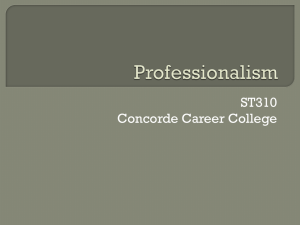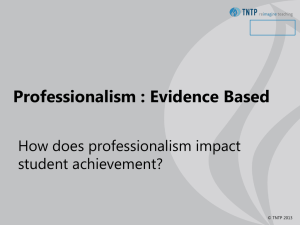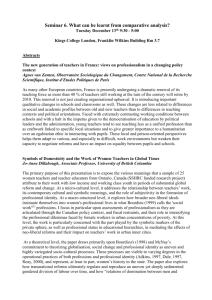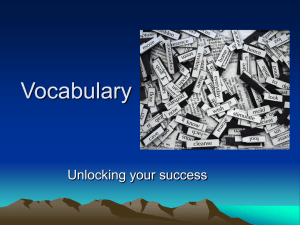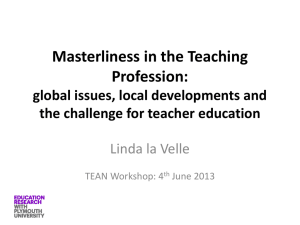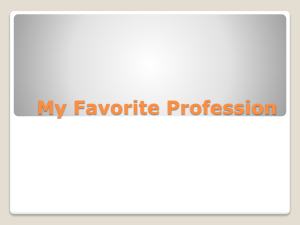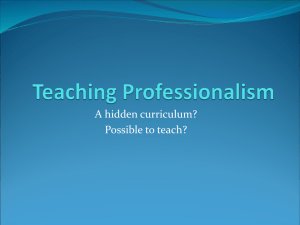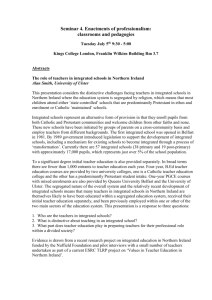Professionalism - Lynn`s Lecture Help
advertisement
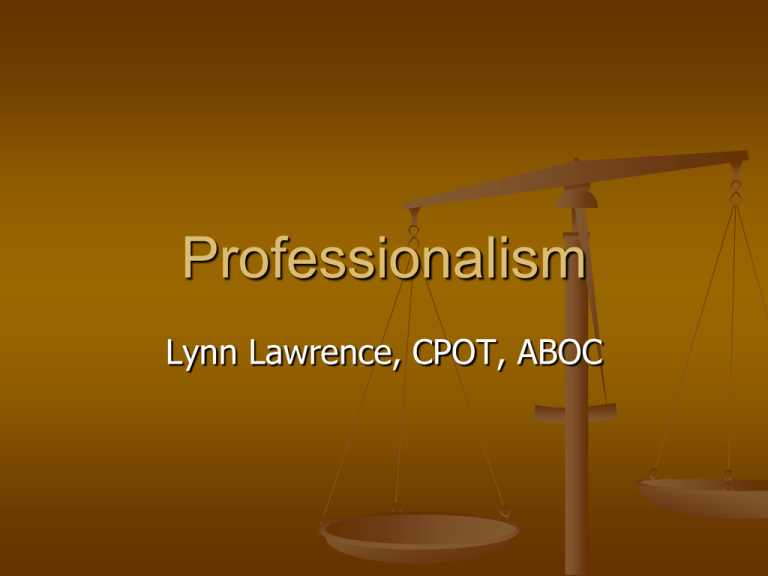
Professionalism Lynn Lawrence, CPOT, ABOC Congrats! Para of the South From West Virginia Belinda Coberly The other lady is her sister…just kidding, its her daughter Tess! Communication While attending a marriage seminar on communication, David and his wife listened to the instructor declare, “It is essential that husbands and wives know the things that are important to each other.” He addressed the man, “Can you describe your wife’s favorite flower?” David leaned over, touched his wife’s arm gently and whispered, “Pillsbury All-Purpose, isn’t it?” Overview Cont… Define Professionalism Determining who is a Professional Elements of Professionalism Hindrances to Professionalism How to instill professionalism at work How to get others to see you as a professional Professionalism Webster: the conduct, aims, or qualities that characterize or mark a profession or professional individual Lynn: someone that has learned a skill, understands it’s importance, and continually strives to improve upon it through education and on-the-job training Sports, medicine, law, technical skills, When you fail the entire profession takes a hit! Professionalism is: Having an awareness of how your actions, body language, and words affect others Being accountable for one’s action Learning to master skills of the trade Leading by your example Having a passion that cannot be stopped Professions have a body of knowledge, scope of practice, agreed upon values, oath or code and accountability to our society for their profession and their professional behavior. Professionalism Describes a certain type of behavior in the workplace Based on our values and understanding of our professional roles Evidenced in our behavior Becoming an expert Where do we start? What does professional mean? An occupation requiring specialized knowledge and often long and intensive academic preparation Conforming to the technical or ethical standards of a profession Who Determines No one can tell you if you are a professional You can work in a profession and not demonstrate the traits of a profession Doesn’t matter what you actually do, you can do it professionally You determine if you want to be viewed as a professional How professionalism is judged Against a set of expectations or standards From our own personal values set and understanding of what “professionalism” means May be situational in nature Strongly influenced by culture Elements of Professionalism Education and training (credentials) Participation in a professional organization Attitude (determines altitude) Knowledge of responsibilities Knowing limits of responsibilities Determination Appearance Communication (upward, downward, lateral) Professional is judged through: Our Our Our Our Image Communication Competence Demeanor From the Patient’s Perspective Trustworthy Competent Empathetic Respectful Caring Commitment Accountibility Our relationships with patients: Therapeutic context Safety, trust and ethical behavior are foundational Relationship has boundaries Vulnerability of patients and the imbalance of power Treat patients like your favorite family members From the Co-Workers Perspective Trustworthy Competent Supportive Respectful Accountable Body Language Functional Trust All people have an equal need for respect Respect is the basic foundation of all healthy personal relationships Each team member is equally important Each team member’s work is equally important Mutual respect All people have an equal need for respect Respect is the basic foundation of all healthy personal relationships Each team member is equally important Each team member’s work is equally important Hindrances Not knowing your job Poor communicator Failing to understand impact of actions Poor decision making Poor language Personal conduct on and off the job Not keeping current with trends in profession Dress and appearance Poor or Bad Attitudes Professionalism is NOT! Blaming others Waiting for others to take the lead Bringing drama to situations Losing your composure Making excuses Letting your ego take over Having a bad attitude Developing the Staff Ensure everyone is learning something all the time Ensure everyone understands what is expected and what is at stake Establish efficient lines of communication Instill an atmosphere of teamwork Identify all stakeholders Accountability is a must…documentation! Others/You Professionalism Train Tell, show, watch, agree Look the part Speak the part Communicate the part Always be aware Get feedback Practice at home Personal Professional Development Don’t wait for someone else to train you Don’t work for an office that is professionally blocking your dreams and goals Don’t make excuses, make plans and stick to them Get involved in your future…develop career path to success and follow it… Find others to get involved in your future Become an expert Don’t forget, it is your future Ways to Develop Your Professionals Examine what you want…be the example Set clear borders Teach staff how to learn Find great examples Educate, educate Explain office values Teach tactical/ strategic thinking Create an environment that encourages development Develop a clear advancement plan Find out about staff personal goals Write down the career path/review quarterly Recognizing Professionals Professionals are always learning Professional conduct demonstrates learning Professionals are focus on the profession Professionals connect with the profession Professional know what they are doing Professionals look, talk, reflect their roles Professionals are loyal to the profession with in their actions Professionals look for ways to advance the profession You never have to look for a professional Professional Issues National roles and functions of the professional…get involved Liability and malpractice Conduct, confidentiality, and ethics Hygiene and Infection Control Asepsis Cross contamination Sterilization 7 Steps on How to go Interview Step 1 Learn the basics and make a positive impression Step 2 Know who you are and what you can do Step 3 Do your homework and come prepared Step 4 Answer key interview questions with ease Step 5 Handle tough questions with confidence Step 6 Follow up Step 7 Negotiate your way to a fair salary Always do your best. What you plant now, you will harvest later. Og Mandino Quote One day I had to be the bearer of bad news when I told a wife that her husband had died of a massive myocardial infarct. Not more than five minutes later, I heard her reporting to the rest of the family that he had died of a "massive internal fart." Helpful Tools? Go to http://www.yoyobrain.com • Find flashcards and documents related to this presentation • Set goals to help you study for your certification exam • Keep track of what you do and do not know, so you can learn quickly and efficiently martralyn@msn.com Thank you very much… Bless you all…
